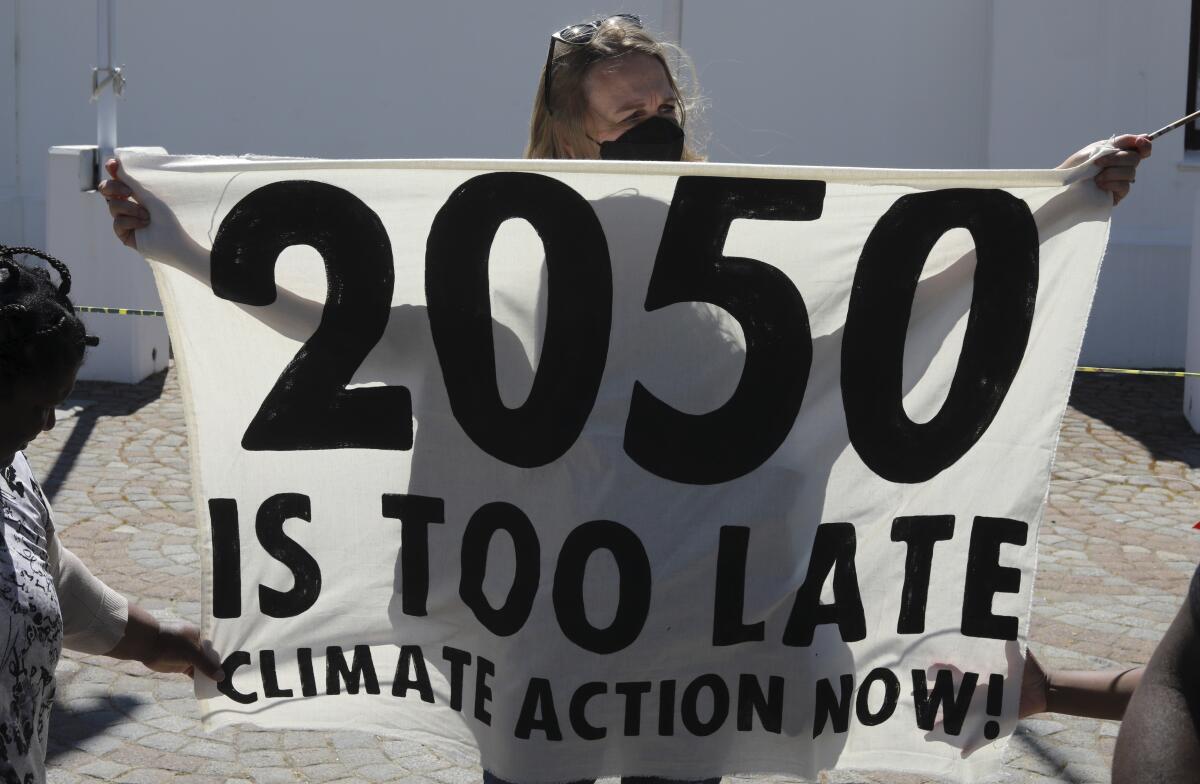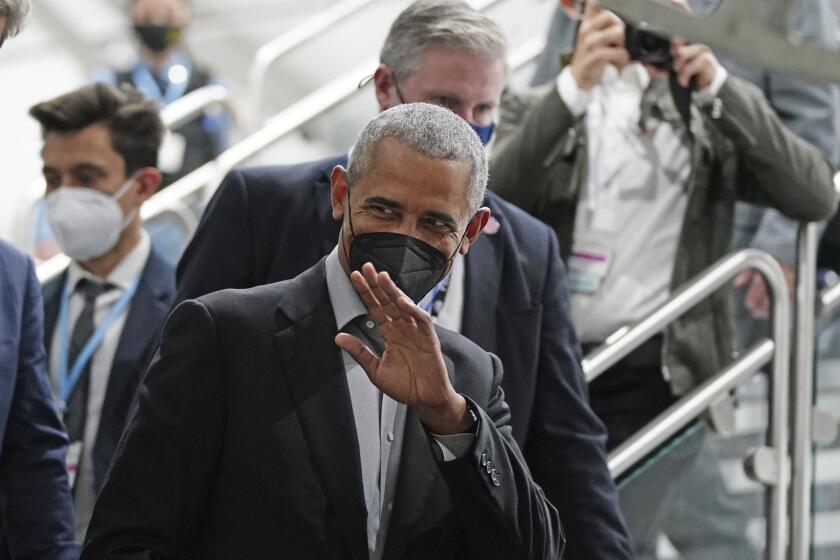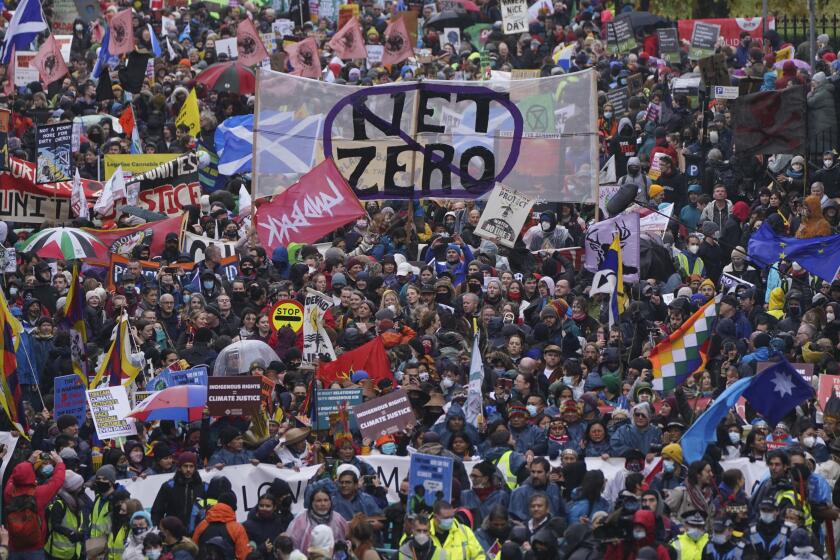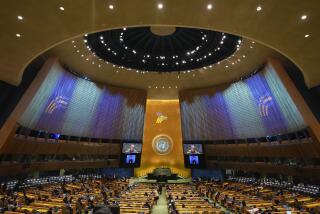Goals are far out of reach at United Nations climate talks

GLASGOW, Scotland — The United Nations climate summit in Glasgow has made “some serious toddler steps” toward cutting emissions but far from the giant leaps needed to limit global warming to internationally accepted goals, two new analyses and top officials said Tuesday.
And time is running out on the two weeks of negotiations.
The president of the climate talks, Alok Sharma, told high-level government ministers at the U.N. conference to reach out to their capitals and bosses soon to see if they can get more ambitious pledges because “we have only a few days left.”
This month’s summit has seen such limited progress that a United Nations Environment Program analysis of new pledges found they weren’t enough to improve future warming scenarios. All they did was trim the “emissions gap” — how much carbon pollution can be spewed without hitting dangerous warming levels — a few tenths of a percentage point, according to the review released Tuesday.
The analysis found that by 2030, the world will be emitting 51.5 billion metric tons of carbon dioxide each year, 1.5 billion tons less than before the latest pledges. To achieve the limit first set in the 2015 Paris climate accord, which came out of a similar summit, the world can emit only 12.5 billion metric tons of greenhouse gases in 2030.
A separate analysis by independent scientists found a slight decrease in future warming, but one still insufficient to limit the warming of the planet to 1.5 degrees Celsius (2.7 degrees Fahrenheit) by the end of the century. The planet has already warmed 1.1 degrees Celsius (2 degrees Fahrenheit) since preindustrial times.
Former President Obama is expressing confidence that the Biden administration will ultimately get its $555-billion climate package through Congress.
“There’s some serious toddler steps,” United Nations Environment Program chief Inger Andersen said in an interview a few minutes after the U.N. analysis was finished. “But they are not the leaps we need to see, by any stretch of the imagination.”
In Glasgow, officials touted advances, but not necessarily success.
“We are making progress,” Sharma said, “but we still have a mountain to climb over the next few days, and what has been collectively committed to goes some way, but certainly not all the way, to keeping 1.5 within reach.”
Andersen acknowledged that none of the three main U.N. criteria for success for the two-week climate talks has been achieved so far. They are cutting greenhouse gas emissions by about half by 2030; securing $100 billion a year in aid from rich countries to poor nations; and having half of that money be for developing nations to adapt to global warming’s worst harms.
The second analysis was done by Climate Action Tracker, which for years has monitored nations’ emission-cutting pledges. It said that based on those submitted targets the world is now on track to warm 2.4 degrees Celsius (4.3 degrees Fahrenheit) since preindustrial times by the end of this century. That’s a far cry from the 2015 Paris climate deal overarching limit of 1.5 degrees Celsius and its fallback limit of 2 degrees Celsius.
Police helicopters were buzzing above Glasgow, Scotland, for a second day of protests outside the U.N. climate summit.
Given what’s been pledged, “we are likely to be in that area [of] 2.4 degrees, which is still catastrophic climate change and far, far away from the goals of the Paris agreement,” said climate scientist Niklas Hoehne of the New Climate Institute and the Climate Action Tracker.
Hoehne’s group, independent of the U.N., also looked at how much warming there would be if other less firm national promises were put into effect. If all the submitted national targets and other promises that have a bit of the force of law are included, future warming drops down to 2.1 degrees.
And in the “optimistic scenario” if all the net-zero pledges for midcentury are taken into account, warming would be 1.8 degrees, Hoehne said. That’s the same figure the International Energy Agency came up with for that optimistic scenario.
Andersen said success is about her great-grandchildren living in a world with warming kept to the level outlined in the Paris accord, and said “the kids on the street” protesting in Glasgow help the United Nations in pushing negotiators to do more.
“Progress happens at meetings. Success is delivered into people’s lives when their livelihoods and their health and well-being is improved,” Andersen told the AP.
U.S. Rep. Alexandria Ocasio-Cortez, who brought her star power to the U.N. climate talks on Tuesday along with House Speaker Nancy Pelosi, told reporters she had a message for those youth protesters: “Stay in the streets. Keep pushing.”
To water resiliency advocates at the U.N. climate conference, the Colorado River stands out as ‘the best example globally of how things can go badly.’
Large rifts remain as United Nations climate talks tick down to a Friday deadline. A lot of the divide comes down to money — which nations have it and which do not. So it’s time for the diplomatic cavalry to ride in.
The start of the conference saw heads of government talking about how curbing global warming is a fight for survival. The leaders focused on big pictures, not the intricate wording crucial to negotiations. Then, for about a week, the technocratic negotiations focused on those key details, getting some things done but not resolving the really sticky situations.
To forge compromise, the countries have a big gap to bridge. Or more accurately, multiple gaps: a trust gap and a wealth gap. A north-south gap. It’s about money, history and the future.
On one side of the gap are nations that developed and became rich from the Industrial Revolution fueled by coal, oil and gas that started in the U.K. On the other side are the nations that haven’t developed yet and haven’t gotten rich and are now being told those fuels are too dangerous for the planet.
The key financial issue is the $100-billion-a-year pledge first made in 2009. The developed nations still haven’t reached that mark. This year, the rich nations increased their aid to just shy of $80 billion a year.
“Everybody here is livid,” said Saleemul Huq, a climate science and policy expert who is director of the International Center for Climate Change and Development in Bangladesh.
Huq said it’s more than just the money; it’s important to bridge the gap in trust between rich nations and poor nations.
“They reneged on their promise. They failed to deliver it,” Huq said. “And they seem not to care about it. And so why should we trust anything they say anymore?”
Still, Andersen and Sharma hold out hope.
“We’re not done yet. We still have a couple of days,” Andersen said. “And so we’re certainly from our side, from the United Nations side, we’re going to try to hold everyone’s feet to the fire.”
More to Read
Sign up for Essential California
The most important California stories and recommendations in your inbox every morning.
You may occasionally receive promotional content from the Los Angeles Times.













